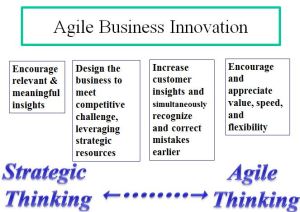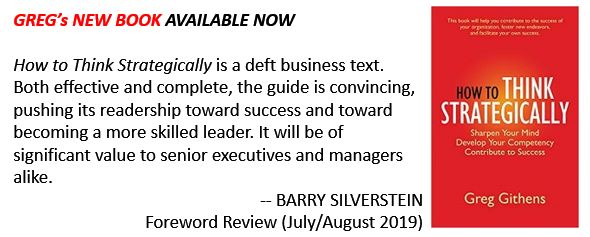 This article is composed of three chapters, all dealing with an emerging term, “agile thinking.” Perhaps you have had similar experiences in your strategic initiatives.
This article is composed of three chapters, all dealing with an emerging term, “agile thinking.” Perhaps you have had similar experiences in your strategic initiatives.
Chapter 1: A Curious Conversation
Recently, a leader of strategic initiative stated, “we don’t need to embrace strategic thinking because we are agile thinkers.” My ears perked up, and I asked a question, “The purpose of strategic thinking is fairly well established (it is to create insights that are useful in crafting strategy). What is the purpose of agile thinking?”
His answer was that agile is about being creative: It is about being flexible, being focused on providing value, being innovative, and doing things fast. His answer was about “being” and “values,” it was not about thinking. I tried asking the question differently, but made no progress with this individual: He clearly had not thought deeply about his “agile thinking” declaration. So, I let it drop.
(As an aside, the strategic initiative floundered and this program manager was replaced. One reason for the situation was the manager was focused more on the agile methodology rather than creating business value.)
Later, I wondered if anyone has put effort into clarifying “agile thinking?” Is there a definitive answer, or least a thoughtful reflection?
I went to Google’s search engine. There are a handful of entries on agile thinking, but no responses to the more constrained search on “purpose of agile thinking.” So here is my conclusion,
In present use, agile thinking means to embrace the “agile values” declared by agile software evangelists, those values being things like flexibility, speed, customer responsiveness, change, and good engineering.
The word “values” is appropriate, as every individual values things differently. Values are both situational and subjective. The value of speed in projects is generally desirable, but that value sometimes is in conflict with safety or productivity or quality. The value of flexibility is also generally desirable, but comes in conflict with systems integrity or cost. The more thoughtful agilists will quickly clarify that they prefer their values but acknowledge the importance of those that seem to be in conflict.
I interpret, then, that most authors are encouragers, “Think about agile values.” The alternative meaning of agile thinking is less prevalent, “think (cogitate) with agility.” The fundamental prescriptions are these: don’t become habitual in your thinking or behavior. Don’t be burdened by the past: try new things, experiment, innovate. Taking all the the agilists are saying, it seems to me that:
As a cognitive process, there are no practical differences
between agile thinking and creative thinking.
Do you agree with my conclusions?
Chapter 2: Corning’s Strategic Initiative: Agile Business Innovation
Last summer, I was asked to review an article in Strategy + Business, The Gorilla of Agile Business Innovation. Corning has a rather interesting initiative underway. The article tells us that:
“In the fall of 2012, Chairman and Chief Executive Officer Wendell P. Weeks started telling the Corning innovation team, led by Chief Technology Officer David L. Morse, that the company’s established RD&E [Research, Development, and Engineering] practices were neither good enough nor fast enough. Recognizing intensifying global competition and Wall Street’s never-ending demands for higher profits, Weeks began calling for “agile” innovation—an approach that would enable Corning to respond immediately to the needs of customers, as it famously did in 2007 when Steve Jobs asked the company for a better cover glass for the wave of Apple iPhones about to be launched. The company is currently dispatching its Ph.D. researchers to proactively develop more big opportunities.”
The remainder or the article tells us that Corning is practicing things that are encouraged by agilists:
- It intends to develop more intellectual property and commercialize it faster
- It is connecting its best scientists directly to the customer
- It is thinking about risk differently: stepping outside of established process where there is customer opportunity
- Its managers are practicing servant leadership; removing barriers for the project teams
- It is practicing more cross functional collaboration
My client asked me to use the Corning example to help its audience of product developers to understand agile. Using the “translation” that agile thinking means embrace agile values, I developed the nearby graphic.
I intended to show agile business innovation as a vision, supported by four pillars, each pillar holding a conceptual underpinning. From right to left, the explanation is:
- Agile thinking is about encouraging and appreciating value, speed, and flexibility.
- Agile thinking (again, agile being a set of values) encourages experts to communicate better and to recognize mistakes earlier. Hence, tools like scrum, iteration, and burn down charts have emerged.
- In order to face current and emerging competitive challenges, business design and redesigned themselves. How? They leveraging certain resources that are “strategic” in their nature and effect.
- Strategic thinking is about encouraging relevant and meaningful insights to the design of strategy.
This graphic stimulated good discussion and understanding. By clarifying that we are talking about values, we can then turn our attention to the appropriateness of the values to the situation. We can design an approach that best maximizes our chances of success.
Chapter 3: Agile Thinking and Habits Overcoming Status Quo Thinking
During my Google research on agile thinking, I found a set of thoughts from Ken Schwaber titled, Scrum is Hard and Disruptive. He twice points to the problem of habits, writing that “The most serious impediments to using Scrum are habits” and “These are inbred habits that we aren’t even aware of anymore.” Schwaber continues, “The focus of using Scrum is the change from old habits to new ways of doing business.”
Schwaber is a thoughtful guy, and he pins down the essence of the challenge for agilists: there are entrenched habits practiced by individuals, and solidified by organizational processes. The implication here is very important – strategic – even: These habits need to be recognized and replaced.
Importantly, habits perpetuate the status quo. Habits perpetuate the culture, both the cultures strengths and the culture’s weakness.
The core challenge for agilists is that they are saying that their values might be better than their audience’s values. They want to change habits, but often lose sight of whether changing habits is good for the business.
Conclusion: The Implications for Strategic Initiative Leadership
The literature on habits and changing habits is vast. So let me close out this article by suggesting that the path forward for strategic initiative leadership is to look closer at habits. Your questions might be along the lines of these:
- What behavioral and thinking habits of individuals are getting in the way of progress?
- How do these habits get manifested into organizational processes? Are the processes appropriate for the current business reality?
- Do we get more leverage by focusing on changing individual habits AND organizational processes? Or should we change the process, and get individual change through compliance?
- Might we learn anything from the study of addictions (which are habits) that is appropriate for our change effort?
- How might we build our proposed ideas into a story about improving business performance, such as how Corning has done?
Agile thinking is about values. Do you agree? Isn’t the core of organizational change an effort to remove dysfunctional habits and replace them with new habits? What do you do if the habit is not dysfunctional, but rather a value that you disagree with?


Pingback: February Goals Update - Relevant Wit
Pingback: Why more companies should adopt the Facebook mantra to foster innovation | Social Score Media | insights on social, tech, marketing and productivity
Pingback: Design and Agile Thinking | E-WOT
Pingback: How Agile Thinking, Human-Centered Design, and Lateral Thinking differ from each other – Jonah Baer
Pingback: Blog #2 – Andree Riley's Blog
Pingback: Innovation Frameworks – Cameron's Blog
Pingback: Reframing the Digital Transformation conversation in 5 steps – Agile Elephant making sense of digital transformation
Pingback: Enterprise hits and misses - CIOs take the digital plunge, but digital transformation needs buy-in
Pingback: Reframing the Digital Transformation conversation in 5 steps - Enterprise Irregulars